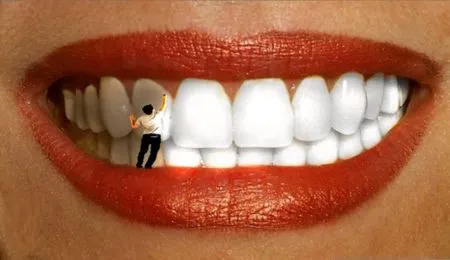- Dental nerve extraction: in which cases it is indicated
- Modern technique of tooth nerve extraction
- Stages of nerve removal
- Does it hurt to have a nerve removed?
- What happens if you don’t remove the nerve from a tooth?
- How long does a tooth live after a nerve extraction?
- What happens after a nerve is removed from a tooth?
- Frequently asked questions about tooth nerve removal
- Specialists
Tooth nerve removal is a procedure in which the doctor removes the nerve tissue inside the tooth. The procedure may be indicated in a variety of cases, but most patients are apprehensive about it. When should I have a tooth nerve removed and what is the treatment like?
Dental nerve extraction: in which cases it is indicated
The pulp is the tissue inside the tooth. It is full of blood vessels and nerves, which is why doctors simply say “the nerve of the tooth”. In some cases, the pulp becomes inflamed and pulpitis occurs. In this case, patients often feel severe pain.
Specialists of the clinic of family dentistry “Dent-House” in Odessa fight for every healthy tooth and strive to keep it alive. However, there are cases when it is impossible to do without nerve removal (endodontic treatment):
- If you have severe tooth pain that does not go away. Usually patients immediately realise that the pulp is inflamed: the pain is severe, wavy, and may be pulsating. The sensation increases after eating hot or cold food, as well as at night. This pain is usually associated with inflammation or infection of the pulp inside the tooth. In the early stages of treatment, the doctor may try to save the nerve, but if delayed, the disease destroys the tooth down to the root. Removing the pulp will help relieve pain and prevent the infection from spreading further.
- If decay reaches the pulp, it causes it to become inflamed. To save the tooth, nerve extraction is often recommended.
- Damage to a tooth, such as a blow or trauma, can damage the pulp and cause inflammation. Nerve removal is necessary to restore the health of the tooth after an injury.
- If the previous treatment of the tooth did not lead to a proper result or if there are problems after root canal treatment.
- For crowns or bridges, in most cases the pulp must also be removed. However, not in all cases: for example, if you are placing ceramic crowns or veneers, the nerves can be saved.
Depulping allows you to save your own tooth and avoid having it extracted. This procedure helps to relieve pain and prevent the spread of infection. However, every case is different and only a doctor can tell you whether you need a depulpation or not. He will also tell you the final cost of treatment after an examination.
Modern technique of tooth nerve extraction

Modern endodontic treatment is painless and its price is quite reasonable. If in the past arsenic was used to remove the pulp, now it is not relevant. Firstly, poison is not always safe for the patient, and secondly, this method is quite painful. Therefore, dentists in the Dent-House clinic remove the pulp in one session with the help of modern equipment. Sometimes doctors resort to another method: they can use a drug to kill the nerve (these are modern and safe drugs) and relieve severe inflammation of the pulp. The tooth is then closed with a temporary filling. After 2-3 days, the medicine is removed, the canals are cleaned and filled.
In some cases, partial depulpation is possible. For example, if caries has affected only the upper layers of the pulp and the deep pulp remains intact, the doctor can remove only the damaged areas.
In most cases, a complete depulpation is performed, especially if the disease has spread to the entire pulp or there is a risk of further damage or infection.
The method is chosen depending on the patient’s specific situation. It should be noted that the choice of treatment method also affects its price.
Stages of nerve removal
The treatment is carried out in several stages:
- The dentist takes x-rays to find out the condition of the tooth and the pulp, to see focus of inflammation and the shape of the tooth canals.
- The doctor uses special rubber dams or cofferdam to keep the working area clean and dry during the procedure.
- A local anaesthetic is provided.
- Using a drill, the doctor removes decay and opens the root canals of the tooth, gaining access to the pulp.
- The pulp is removed from the root canals using special instruments – pulpoextractors.
- To remove bacteria and other germs that can cause infection, the tooth canals are cleaned and disinfected.
- After cleaning and disinfection, the canals are filled with special materials. This is necessary to prevent re-infection and to preserve the tooth structure.
- After the canals are filled, the doctor takes a second X-ray to make sure everything was done correctly.
- After root canal treatment is complete, the tooth is covered with a filling or crown to restore its function and appearance.
Modern techniques and instruments allow dentists to perform nerve extractions efficiently and safely. The tooth is preserved as much as possible and the patient feels no pain.
Does it hurt to have a nerve removed?
In modern dentistry, any treatment is painless. Depulpation is no exception. All you may feel is a slight discomfort due to the doctor’s manipulation of the instruments and the fact that you have to keep your mouth open for a long time.
During endodontic treatment, the doctor uses a local anaesthetic to anaesthetise the area around the tooth. First, he applies a special gel or ointment that makes the gum go numb, and then gives an anaesthetic injection. As a result, the area for further manipulations of the dentist is completely anaesthetised and the patient feels nothing.
According to reviews, even after the treatment is completed, patients do not feel pain, however, in some cases there may be discomfort for 1-2 days after visiting the dentist. This issue is easily resolved by taking painkillers. Therefore, safely make an appointment at the clinic of family dentistry “Dent-House” in Odessa to feel happy again. You can find out how much the treatment costs from the receptionist.
What happens if you don’t remove the nerve from a tooth?
If the inflamed pulp is not removed, it can lead to serious consequences:
- Constant pain and discomfort that will significantly reduce your quality of life. You will not be able to eat and sleep properly, which will lead to GI and general health problems.
- An inflamed nerve is a source of infection that can spread through the tooth’s root canals and further into the surrounding tissues, causing abscess, periodontitis, and other serious problems.
- In some cases, nerve inflammation can lead to the destruction of the root tissue of the tooth and tooth loss. The tooth will have to be extracted and then replaced with a prosthesis. This is a rather long procedure and the cost of such treatment is quite high.
- Sometimes pulpitis can lead to periodontal disease or vice versa, so keep a close eye on your oral health.
- An infection in the tooth can lead to pustules and tissue destruction, bad breath.
- Infection from the tooth can enter the bloodstream and cause serious illnesses such as septicaemia, which requires urgent medical intervention.
All these problems can be avoided if the nerves are removed in time, the canals and the tooth itself are filled. It is therefore important to see a dentist if you feel pain.
How long does a tooth live after a nerve extraction?

After the nerve is removed, the tooth continues to live as before. The nerves are mainly responsible for the sensation of pain, but not for the vitality of the tooth. The tooth itself continues to receive nourishment through the blood vessels in its roots and alveolus (the bony cavity in which the tooth sits). However, it becomes more brittle and the enamel loses colour – becoming grey and dull. With good care and professional maintenance, the tooth will last for many years.
What happens after a nerve is removed from a tooth?
After the procedure, you may feel slight sensitivity or discomfort in the tooth, especially for a few days. In general, you will no longer feel pain as the tooth does not react to external stimulus, but it remains functional. It is important to continue to care for the tooth as you have in the past – good oral hygiene, regular visits to the dentist, including professional dental cleanings, and monitoring any changes in the condition of the tooth or surrounding tissues.
If you suspect pulpitis or want to come for a preventive appointment, call the Dent-House Family Dentistry Clinic in Odessa. Qualified doctors who will perform treatment and restoration of teeth of any complexity, innovative equipment, cosy interior are waiting for you here. Pre-registration for an appointment will save you from having to wait for a doctor’s appointment.
Если вы подозреваете пульпит или же хотите прийти на профилактический прием, звоните в клинику семейной стоматологии Dent-House в Одессе. Здесь вас ждут квалифицированные врачи, которые выполнят лечение и реставрацию зубов любой сложности, инновационное оборудование, уютный интерьер. Предварительная запись на прием избавит от необходимости ждать приема врача.Frequently asked questions about tooth nerve removal
🦷 When is it necessary to remove a nerve in a tooth?
😁 How is the dental nerve removal procedure performed?
🦷 Is it painful to remove a tooth nerve?
😁 What should you do after removing a tooth nerve?
Cost of services
Specialists

Semenyuk Ekaterina Sergeevna
Dentist

Kirilyuk Yulianna Ivanovna
Pediatric dentist

Furduy Ekaterina Sergeevna
Pediatric dentist








